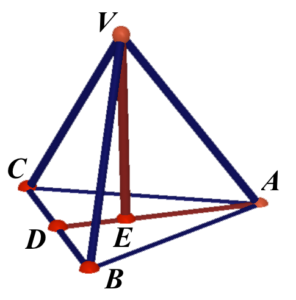Let $2x\text{ cm}$ be the length of a side of the tetrahedron. Note that every face of the tetrahedron is a equilateral triangle.

Consider the base equilateral triangle $ABC$. Add a point $D$ on $BC$ such that $AD\perp BC$ and $BD=CD$. $E$ is the centroid of $\Delta ABC$.
$\begin{array}{rcl}
AC^2 & = & AD^2 + CD^2 \\
(2x)^2 & = & AD^2 + x^2 \\
AD & = & \sqrt{3}x \text{ cm}
\end{array}$
Since $E$ is the centroid of $\Delta ABC$, $AE:ED=2:1$. Hence. we have $AE =\dfrac{2\sqrt{3}}{3}x\text{ cm}$. In $\Delta VEA$,
$\begin{array}{rcl}
VA^2 & = & VE^2 + AE^2 \\
(2x)^2 & = & (2)^2 + (\dfrac{2\sqrt{3}}{3}x)^2 \\
4x^2 & = & 4 + \dfrac{4}{3}x^2 \\
\dfrac{8}{3} x^2 & = & 4 \\
x^2 & = & \dfrac{3}{2} \\
x & = & \sqrt{\dfrac{3}{2}}
\end{array}$
Therefore, the area of $\Delta ABC$
$\begin{array}{cl}
= & \dfrac{1}{2} (BC)(AD) \\
= & \dfrac{1}{2} \times \left(2\sqrt{\dfrac{3}{2}}\right) \times\left(\sqrt{3}\times\sqrt{\dfrac{3}{2}}\right) \\
= & \dfrac{3\sqrt{3}}{2} \text{ cm}^2
\end{array}$
Hence, the volume of the tetrahedron
$\begin{array}{cl}
= & \dfrac{1}{3}(\text{area of }\Delta ABC)(VE) \\
= & \dfrac{1}{3} \times \dfrac{3\sqrt{3}}{2} \times 2 \\
= & \sqrt{3} \text{ cm}^3
\end{array}$

